Persistently mysterious; indubitable genius: Manet’s Le Déjeuner sur l’herbe

It’s a mystery to us all. Just why would a naked woman be sitting with two clothed men in the middle of the forest? Are they not hot? Is she not cold? Why is there an uneaten picnic, and why does the background look so flat, almost like stage scenery? What is the woman in the background doing and why is the woman in the foreground looking at us with such fervour?
Ever since it’s sensational first appearance at the Salon des Refuses in 1863, Le Déjeuner sur l’herbe (luncheon on the grass) by Edouard Manet has given rise to a relentless stream of questions and comparatively few answers. While it’s meaning and narrative might have been profoundly unclear to contemporary audiences, what it did do was shock and inspire in equal measure from the first moment of its appearance. It disgraced the reserved Parisian audiences of the 1863 Salon des Refuses, spurred on by a sensational outcry in the press, outraged to see a shockingly unapologetic female nude staring out at the audience so audaciously and mixing with fully clothed civilised gentlemen. But in equal measure it inspired: It was art for art’s sake – not retelling a classical mythological tale as was common at the time – this was a large canvas reserved for every day life. It was a work which exposed the artist’s active hand through visible brush strokes and a hastily composed background. It was a nude woman whose every crease and curve was unflatteringly exposed, ending the previous hypocritical use of nudes as a representation of deity in all their smooth perfection – here was a real woman, with folds of flab and an unwavering gaze. Unsurprising then that this painting became the touchstone of a new impressionist movement, a movement of artists who would circle around Le Déjeuner’s maker, Manet, making him their leader, a movement which would change the course of art history forever.
No surprise then that despite the initial outcry caused by the image, Le Déjeuner sur l’herbe has gone on to inspire countless generations of artists, and has become an artistic icon of our times. The work has always been one of my favourites of the (pre-)impressionist era, and I too have been inspired to recreate the scene in my own individual way (and yes, it involves Norms!). I’ll be unveiling my finished work tomorrow, but before I do, it seems only appropriate that the original work and those works which have followed in its shadow should be separately analysed, not least because of the sheer number of artists who have been similarly inspired by the work.
However, before looking at the subsequent reinventions of the work, it is interesting to note the possible sources of Manet’s inspiration as he set about painting this work. It is now thought that Manet was at least partly inspired by two works which would have been staple masterpieces of his time. The first is The Judgment of Paris by Marcantonio Raimondi (above). The engraving, which itself was based on a work by Raphael and copies of which would have been widely distributed at the time Manet set to work on Le Déjeuner includes a familiar composition in the bottom right hand corner. Here, a water nymph and two river gods are sat on the ground watching the judgment of Paris in poses which are exactly reminiscent of the poses adopted in Le Déjeuner sur l’herbe. It may well have been that when deciding to reference these poses, Manet was making a purposeful reference to the judgment of Paris as being like the judgment of paintings submitted to the Salon, the annual open art exhibition of Paris for which Manet’s work, as with every other artist’s work in Paris at that time, was intended. For Manet, it was important to be accepted by the unforgiving group of Salon judges, but only on his terms. Therein lay the difficulty. Nudes were very popular at the time, generally as mythological characters, and it is possible that in painting his very realistic confrontational nude, Manet was both aiming to please the Salon, while also sticking a finger up at their traditions – giving with one hand, and taking away with the other. As for Manet’s decision to mix his nude with clothed male characters, it is likely that Manet took inspiration from Pastoral Concert (c.1510) attributed to Titian and a gem of the Louvre collection. Here two contemporaneously clothed men are joined by two naked nymphs – but this was excusable being that the nymphs were inherently and permanently naked.
Here an interesting point arises. In subsequent xrays of Le Déjeuner sur l’herbe, it has been revealed that the pile of clothes on the left of the scene was actually a last minute addition by Manet. It is therefore highly possible that in first painting the scene, he wished to conform with Salon standards by painting two contemporaneously dressed men being visited by a classical nymph, or two (and thus representing an up-to-date reinvention of the Titian work). It was only towards the completion of his work, perhaps realising that despite his coarse brush stroked finish and striking pose of the nude, his work was not going far enough to be innovative and daring, that he decided to add the discarded clothes, thus transforming the nude from a nymph into an everyday woman (it is highly possible he would have added the light chiffon clothing to the woman in the background at the same time). In adding these clothes, Manet transforms the entire tenor of the piece, from mythological pleasantry into a scene of social scandal, as ladies of the time would have recognised the nude as a prostitute consorting with well-bred gentlemen, while the gentlemen in the audience would have undoubtedly felt judged and debased by the direct unwavering gaze of the nude as if to say: “remember me? I’m the one you had behind your wife’s back in Montmartre last night”.
If it was a stir Manet wanted, it was a stir he got, and the painting was, predictably, refused by the Salon judges. Luckily, owing to the number of complaints made by refused artists that year, the Emperor Napoleon agreed to stage a separate exhibition of the refused artists and so Le Déjeuner sur l’herbe lived to see another day.
By the time Pablo Picasso saw the painting in the Paris Universal Exposition of 1990, the painting was already a national treasure, representing France in its international pavilion. Picasso, as with numerous artists before and after him was awestruck by the piece, so much so that later in his career, he spent three obsessive years working and reworking variations on the piece, making some 150 sketches, 27 paintings, 3 linocuts and 18 cardboard models for sculptures based on Manet’s original. It seems only appropriate that from one father of a new artistic heritage to another pioneer of modern art in Europe, Le Déjeuner sur l’herbe should forge the reputation of the first, while being subsequently forged further into the popular imagination through the eccentric reinventions of the other.
Here are just a few of Le Déjeuner‘s parodies. Below is the work of Alain Jacquet who, 100 years after the original was painted, took a photo composition of the work and then expanded the photo so large over canvas that it became pixilated, therefore referencing Manet’s use of coarse brushstrokes which was innovative in his time, and further reinventing the idea of abstraction and atomisation in the modern artistic age.
This is the 1981 album cover of the band Bow Wow Wow originally intended for their album See Jungle! See Jungle! Go Join Your Gang, Yeah. City All Over! Go Ape Crazy. However even in the 80s the image caused controversy as the mother of the female lead singer, pictured nude, instigated a Scotland Yard investigation for the alleged exploitation of a minor (she was only 14 at the time the photo was taken) for immoral purposes.
This is one of the slightly less attractive reinventions of the work – an aluminium three-dimensional sculptural recreation of the scene by J Steward Johnson Junior in Grounds for Sculpture, New Jersey. Entitled “Dejéuner Déja Vu” (1994), it is one of several recreations of well known impressionist works in the park, including Renoir’s The Boating Party.
In this photograph, the photographer Mario Sorrenti referenced Le Dejeuner in his 1998 campaign for the Spring/Summer collection of Yves Saint Laurent. Here however the roles are reversed, with Kate Moss wearing the clothes, while the two men take on the role of nude.
Finally, here is Julie Rrap’s 2002 installation: Untitled (after Manet’s Le Déjeuner sur l’herbe). Here she has stripped the original painting bare of its characters, replacing them with bronze forms on the gallery floor.
I could go on, and tomorrow you’ll get to see my recreation of Manet’s masterpiece in addition. For a masterpiece the work surely is, a work which is now accepted at face value, question marks swept aside with the benefit of a modern artistic approach where art is celebrated for arts sake. In Le Déjeuner, we have both a historical artefact and a contemporary icon all rolled into one, a sparkling, much admired gem of Paris’ Musée d’Orsay collection, and a work which is sure to remain in the popular imagination of artists and pop stars and cartoonists and countless others for generations to come.
See you tomorrow!

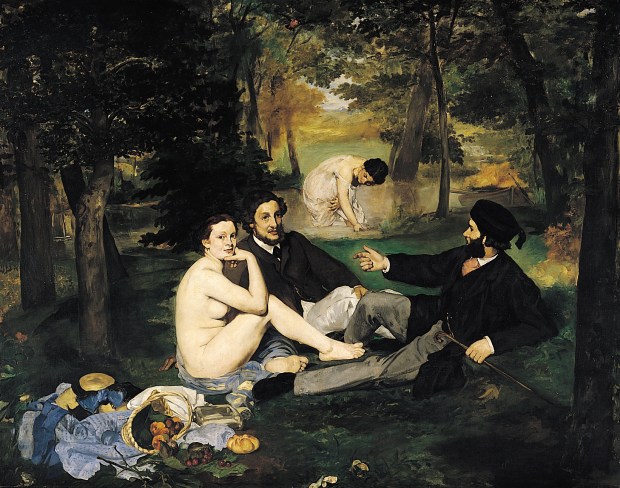


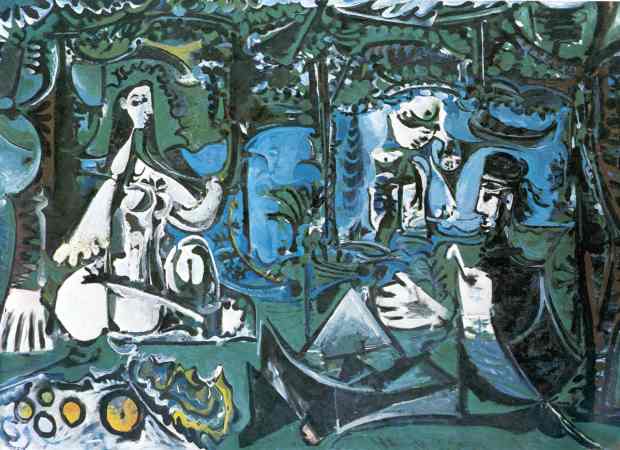
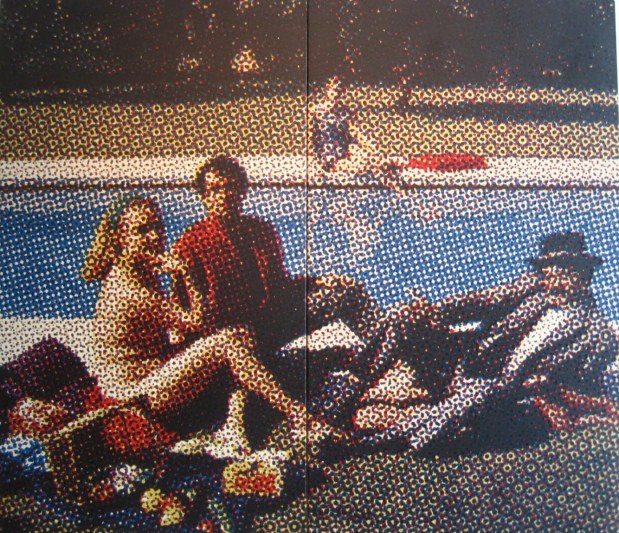
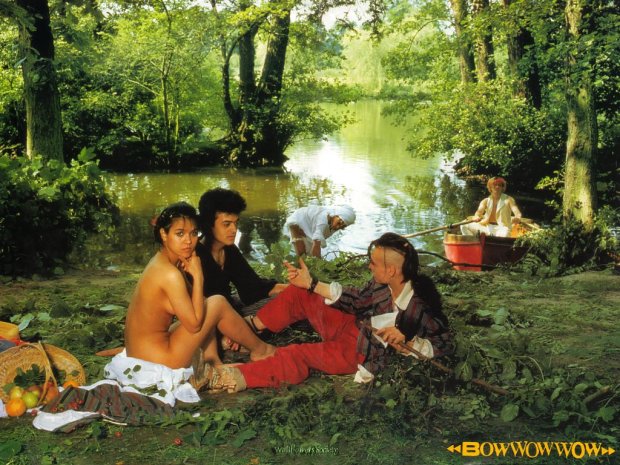


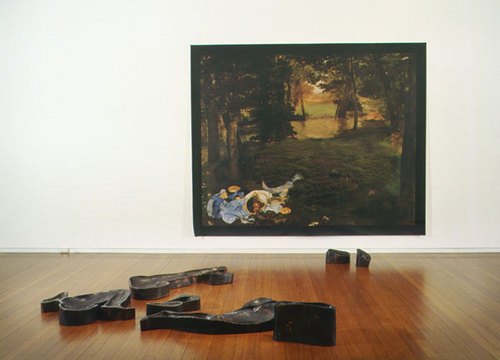






































Trackbacks & Pingbacks